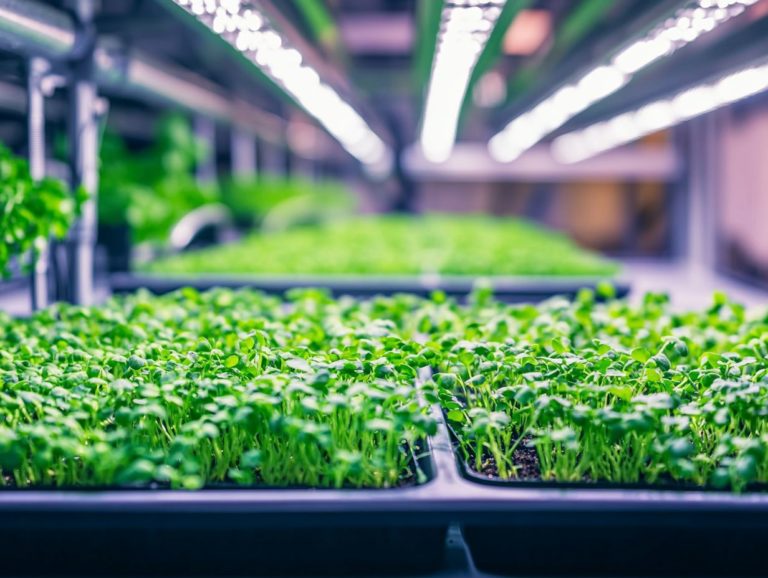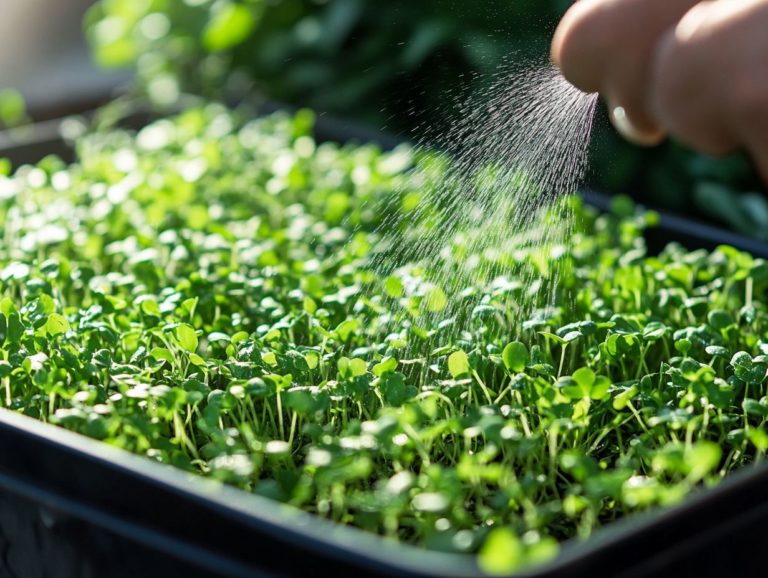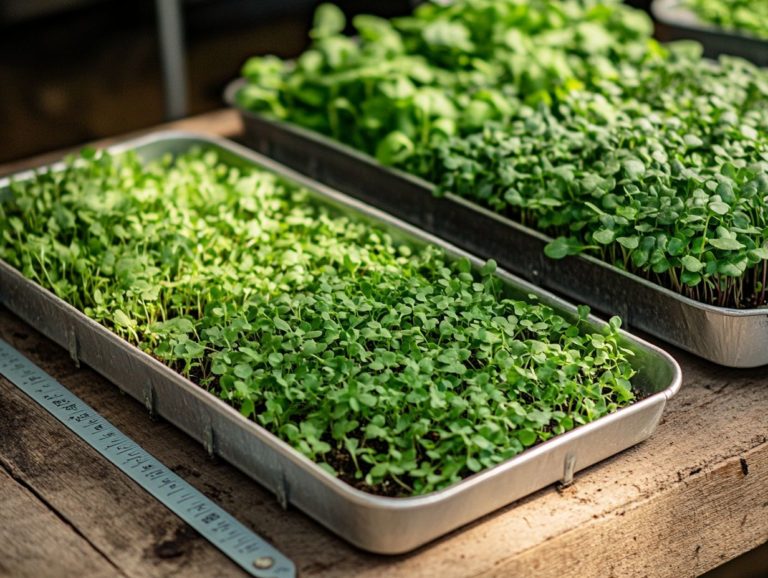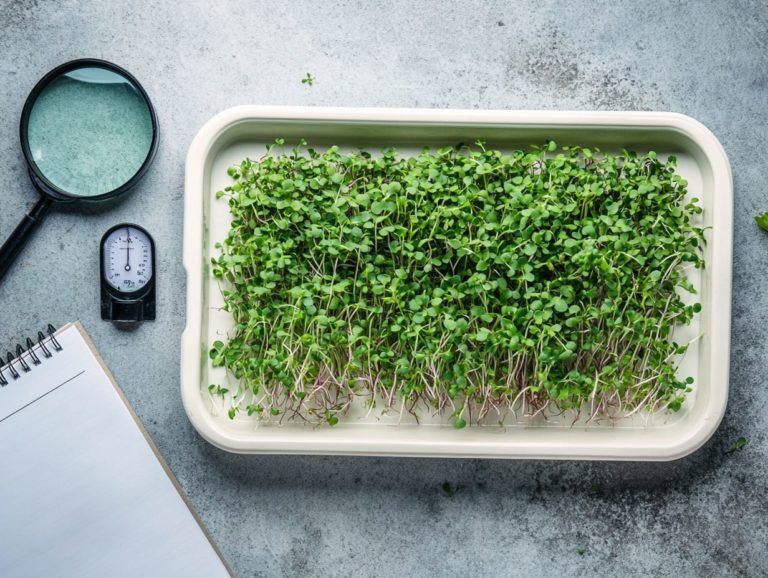The Perfect pH Level for Microgreens
Microgreens are a treasure trove of flavor and nutrients, captivating the palettes of health enthusiasts and chefs alike.
The secret to cultivating these tiny powerhouses rests in an often-overlooked detail: pH levels. Grasping how pH influences plant growth is essential for achieving optimal yields and top-notch quality.
Let s explore the ideal pH for microgreens together! This article guides you on measuring and adjusting it, highlights potential issues linked to imbalanced pH, and offers practical tips for creating the perfect environment for your greens.
Dive in and watch your microgreens flourish!
Contents
- Key Takeaways:
- The Importance of pH in Microgreens
- The Ideal pH Level for Microgreens
- How to Test and Adjust pH for Microgreens
- Potential Problems with pH Levels in Microgreens
- Troubleshooting pH Issues in Microgreens
- Maintaining the Perfect pH Level for Healthy Microgreens
- Frequently Asked Questions
- What is the perfect pH level for growing microgreens?
- Is too much pH bad for my microgreens?
- Can I adjust the pH level for different types of microgreens?
- How can I test the pH level of my microgreens growing medium?
- What are the signs of an incorrect pH level in microgreens?
- Should I adjust the pH level of tap water for my microgreens?
Key Takeaways:
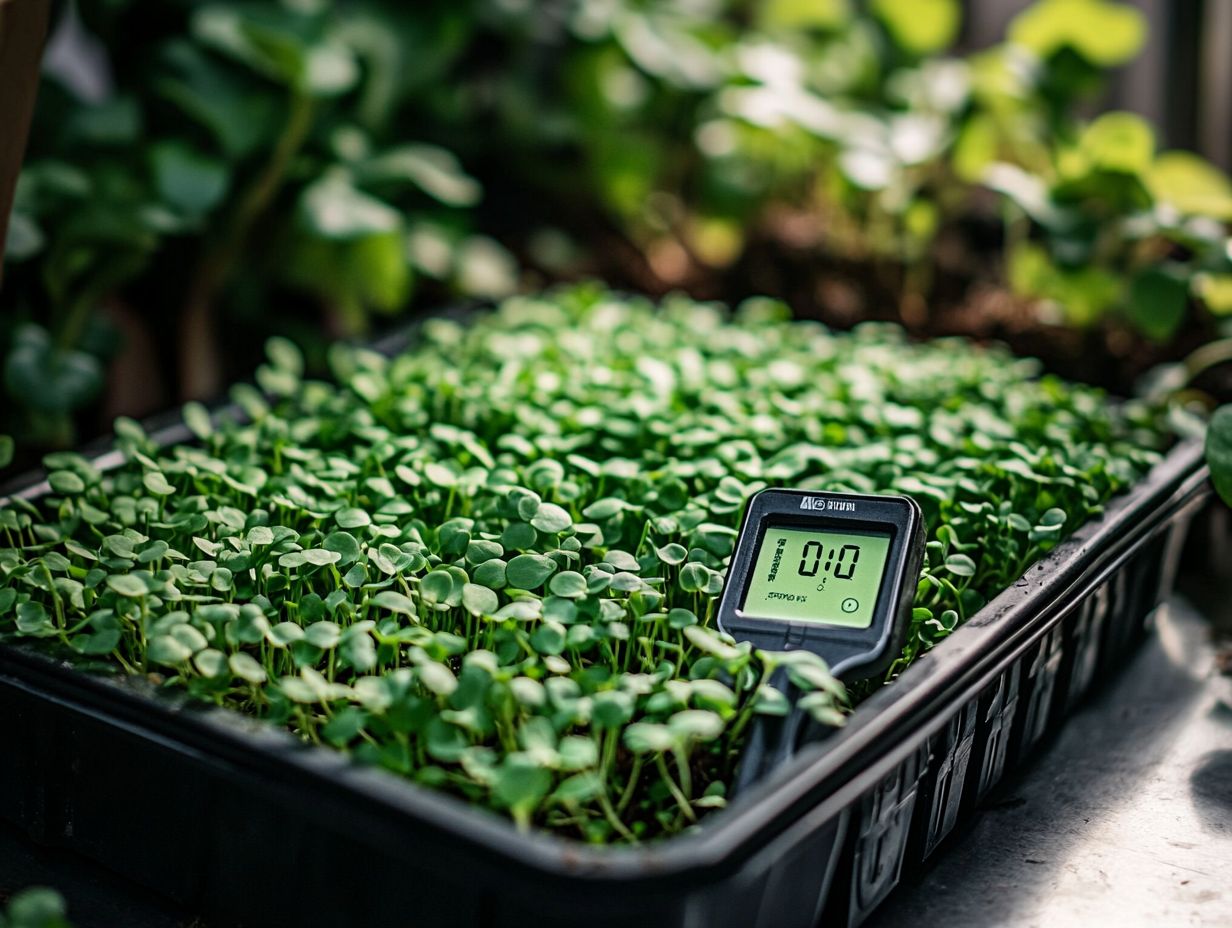
- Understanding the importance of pH in microgreens is crucial for their growth and development.
- The ideal pH level for microgreens is typically between 5.5-6.5, but it can vary depending on factors like water quality and soil type.
- Testing and adjusting pH for microgreens can be done using various methods. Maintaining the perfect level is essential for healthy and thriving microgreens.
The Importance of pH in Microgreens
Understanding the significance of pH in microgreens is vital for achieving optimal growth and enhancing plant health. The pH level of your growing medium, whether you’re using soil or hydroponics, has a big effect on water quality and nutrient availability.
This insight is crucial for both novice and experienced growers alike. Microgreens are particularly sensitive to pH fluctuations, and such variations can lead to less-than-ideal growth or, in the worst-case scenario, crop failure.
Thus, recognizing the role of pH and its effects on nutrient uptake and plant resilience is an essential cornerstone of successful microgreen cultivation.
Understanding pH and Its Role in Plant Growth
pH, measuring the acidity or alkalinity of a solution, is crucial for plant growth, particularly for sensitive crops like microgreens. Grasping this concept enables you to create optimal conditions that enhance nutrient availability.
Using litmus strips offers an uncomplicated method for measuring soil pH. This allows you to see if your growing medium is acidic, neutral, or alkaline.
This insight is vital since pH directly affects the availability of essential nutrients like nitrogen, phosphorus, and potassium. In various growing environments, maintaining the right pH can be the deciding factor between a thriving crop and one that barely gets by.
Even minor fluctuations in soil pH can affect plants in different ways. This underscores the importance of consistently monitoring and adjusting pH levels to ensure robust microgreens.
The Ideal pH Level for Microgreens
The ideal pH level for microgreens generally falls between 5.5 and 7.0. This range is crucial for optimizing nutrient availability and fostering vigorous growth.
Grasping and maintaining this pH balance is vital for both soil-based and hydroponic systems. It ensures that your microgreens can effectively absorb the nutrients they require for thriving development.
Factors Affecting pH Levels
Several factors can influence the pH levels in your microgreens, such as water quality, additives, and environmental conditions. Understanding these elements is crucial for you as a grower seeking to maintain optimal pH levels.
Water quality is particularly important in determining pH. For instance, chlorine, often found in municipal water supplies, can skew acidity levels. Hard water can also disrupt your pH balance and affect nutrient availability.
To address these concerns, you can use household acids like vinegar and lemon juice as effective pH adjusters. By incorporating these natural acids into your routine, you can rectify pH imbalances, enhancing nutrient uptake and the overall vitality of your plants.
This not only helps maintain a stable growing environment but also elevates the flavor and quality of your microgreens. Don t wait! Start monitoring your pH levels today!
How to Test and Adjust pH for Microgreens
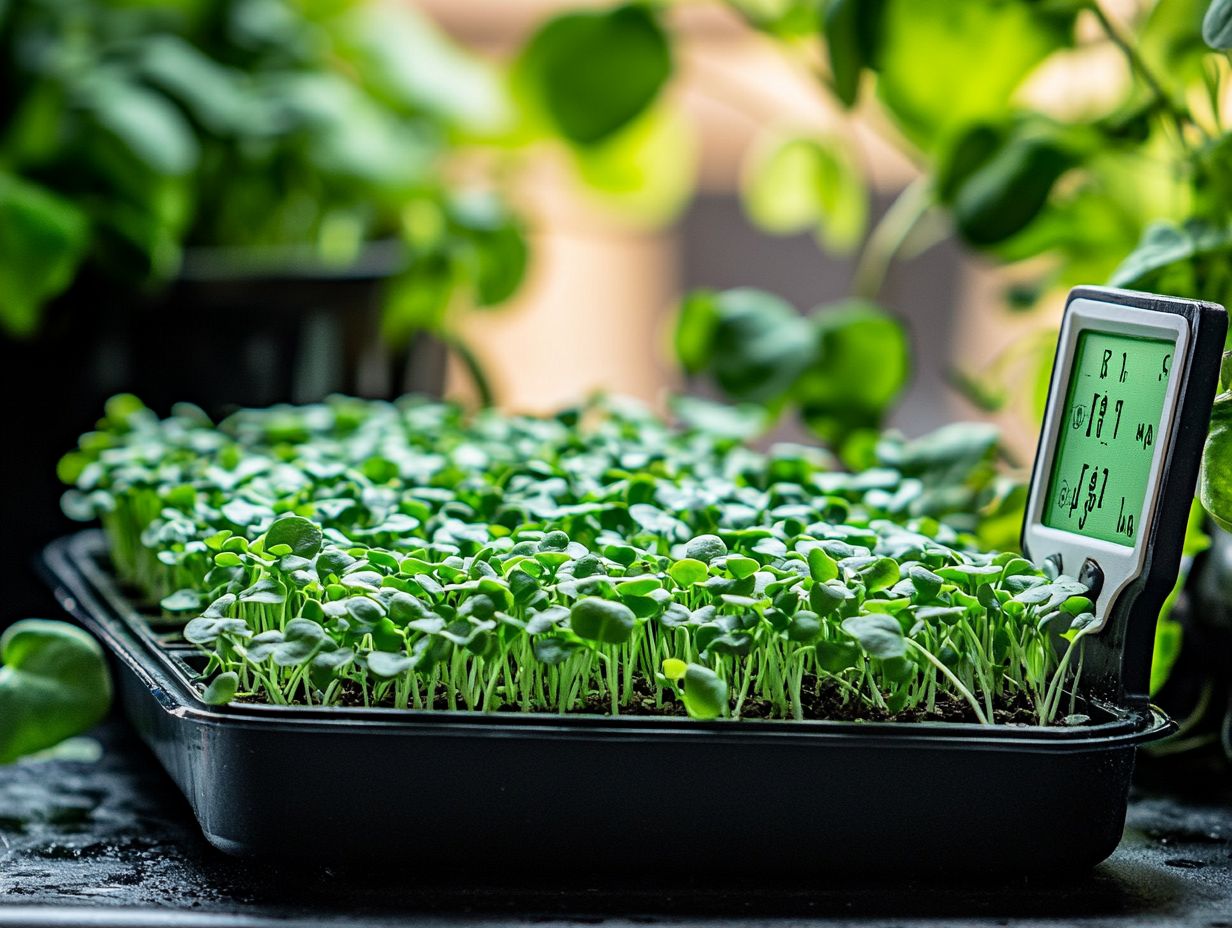
Testing and adjusting pH for microgreens is essential for optimal growth. Using effective methods like litmus strips and pH meters allows you to accurately measure pH levels and create an ideal environment for your crops.
Paying attention to pH levels helps your microgreens thrive!
Methods for Measuring pH
Measuring pH accurately is crucial for microgreen success. You can choose between pH meters or simple litmus strips. Understanding how to test both water and growing mediums is key to maintaining optimal pH levels.
Each method has its advantages and disadvantages. For example, pH meters provide high accuracy and precision, making them ideal for dedicated cultivators. However, they require calibration and can be more expensive. On the other hand, litmus strips are budget-friendly and user-friendly, allowing for quick tests, but they may lack accuracy for certain plants.
Make sure to regularly recalibrate your meters and store them properly for the best results.
Ways to Adjust pH Levels
Adjusting pH levels for your microgreens can be done using pH adjusters like lemon juice, vinegar, or baking powder. These adjustments are crucial for creating an optimal growing environment and ensuring nutrient availability for vibrant growth.
To effectively use these adjusters, start by testing the current pH level of your soil or nutrient solution with a reliable pH meter or test strips. For example, if using lemon juice, dilute one tablespoon in a gallon of water. Apply this mixture gradually while closely monitoring pH changes, aiming for the sweet spot between 5.5 and 6.5.
If you choose vinegar, follow a similar dilution method. Conversely, to raise the pH, use baking powder; simply mix a teaspoon into a gallon of water, especially in more acidic soils.
Carry out these adjustments at the start of the growth cycle and monitor periodically as your microgreens progress. This ensures they consistently access nutrients, setting the stage for healthy and robust growth.
Potential Problems with pH Levels in Microgreens
Imbalanced pH levels can cause significant challenges for your microgreens, impacting both their health and the availability of essential nutrients. By recognizing these potential issues early, you can protect your crops from irreparable damage and ensure a thriving growing season.
Effects of Imbalanced pH on Growth and Quality
An imbalanced pH can dramatically affect microgreen growth and quality, leading to disappointing yields and poor flavor. Understanding these effects allows you to maintain optimal pH levels proactively.
Maintaining the right pH is essential because extreme levels can cause nutrients to become unavailable, such as nitrogen and phosphorus. For instance, microgreens like beet greens and basil are particularly sensitive to pH changes; if the soil is too acidic or too alkaline, their growth can decline. This results in less vibrant plants and can compromise their taste and texture, making them less appealing in the kitchen.
By diligently monitoring and adjusting pH levels, you can ensure robust, flavorful microgreens that thrive, providing maximum satisfaction for both you and your consumers. To learn more about the optimal conditions, check out what’s the ideal pH level for microgreens?
Troubleshooting pH Issues in Microgreens

Troubleshooting pH issues in microgreens involves pinpointing common problems and implementing effective solutions to restore balance to your growing environment.
By understanding the root causes of pH fluctuations, you can take targeted actions to ensure your microgreens thrive in a healthy and optimal setting.
Common Problems and Solutions
Common pH-related issues in microgreens can show up as nutrient blockage, wilting, and lackluster growth. Spotting these problems early allows you to implement effective solutions, ensuring your crops thrive.
Understanding pH levels, which measure how acidic or alkaline a solution is, is crucial for your microgreens’ success! If the pH drops too low, vital minerals like calcium can become locked away, leading to nutrient deficiencies and stunted growth. Additionally, knowing the best temperature for microgreens is essential. Make regular pH testing a priority to keep your microgreens thriving!
If you find acidity is on the higher side, amend your growing medium with lime to help restore balance. Wilting may signal not only a pH imbalance but also inadequate water retention. Refine your irrigation techniques and ensure proper drainage to address this issue.
By maintaining pH levels between 5.5 and 6.5, you lay a solid foundation for healthier, more vigorous microgreens, promoting robust growth and maximizing your yield.
Maintaining the Perfect pH Level for Healthy Microgreens
Keeping the ideal pH level for your microgreens is essential for promoting healthy growth and optimal nutrient absorption. By employing proactive strategies, conducting regular monitoring, and making effective adjustments, you can cultivate a thriving microgreen crop that maximizes yield and enhances quality.
Tips for Consistently Achieving Optimal pH Levels
Consistently achieving optimal pH levels for your microgreens demands a thoughtful mix of routine monitoring and strategic interventions. Embrace specific practices to cultivate an environment that fosters healthy growth and high-quality crops.
Regularly test the pH of your soil or water, as fluctuations can arise from factors like nutrient uptake or changes in the environment. Understanding the precise pH preferences of different microgreen varieties is crucial for knowing the best conditions for microgreens, allowing you to customize your approach and ensure each species thrives in its ideal environment.
Be mindful of the source and quality of the water you use; contaminants or varying mineral content can significantly affect pH levels. Implement adaptive measures like using a spray bottle to adjust nutrient solutions or utilizing water conditioners to counteract any adverse shifts and promote sustained plant vitality for impressive yields.
Frequently Asked Questions
What is the perfect pH level for growing microgreens?
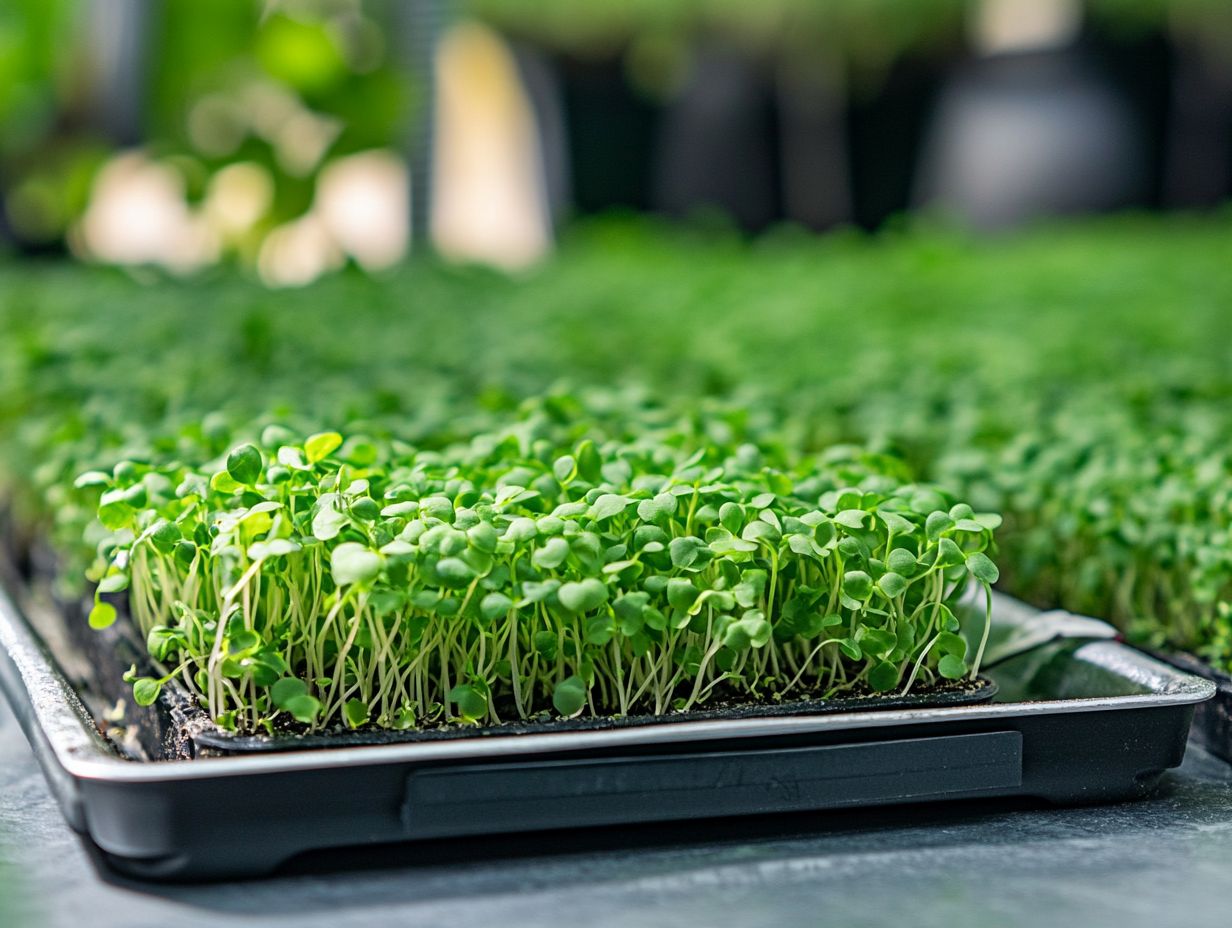
The ideal pH level for growing microgreens is between 6.0 and 6.5. This slightly acidic range allows for optimal nutrient uptake and promotes healthy growth.
Is too much pH bad for my microgreens?
If the pH level is too high, microgreens may experience nutrient deficiencies as some nutrients become less available in alkaline environments. This can result in stunted growth and discoloration of the plants.
Can I adjust the pH level for different types of microgreens?
Yes, the pH level can be adjusted for different types of microgreens. Some varieties may prefer a slightly lower or higher pH level, so researching the specific needs of the microgreens you are growing is important.
How can I test the pH level of my microgreens growing medium?
You can test the pH level of your microgreens growing medium using a MySoil Soil Test Kit or strips, which can be found at most garden supply stores or online. Alternatively, you can send a sample of your growing medium to a lab for professional testing.
What are the signs of an incorrect pH level in microgreens?
Signs of an incorrect pH level in microgreens may include yellowing leaves, slow growth, and poor overall health. If you notice any of these signs, it’s vital to test and adjust the pH level of your growing medium.
Should I adjust the pH level of tap water for my microgreens?
It is recommended to adjust the pH level of tap water before using it for microgreens. Most tap water has a pH level that is too high for optimal growth. You can adjust the pH level by adding a pH adjuster or using filtered water with a lower pH level.



